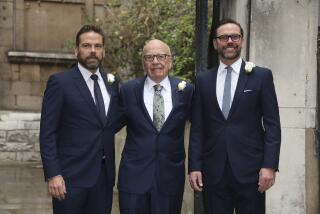Column: Greed and genetics: How our founding newspaper families set the stage for Tronc’s plundering of the New York Daily News
Every narrative needs a compelling villain, and in the unfolding story of the evisceration of the New York Daily News, Michael Ferro is it.
Not that the role doesn’t suit him. Ferro headed Tronc, the newspaper company, until he resigned as chairman and director in May (though he’s still a major shareholder). The company announced at that time it was paying Ferro $15 million for “consulting,” an expense that produced a quarterly loss of about the same amount. On July 23, Tronc laid off half the Daily News editorial staff, leaving a staff of 45 to cover a metropolis of 9 million.
So we have the spectacle of an insider pocketing a big payoff while his company cuts the rank and file to the bone.
In 2016, Ferro, a Chicago entrepreneur, bought a controlling interest in what was then Tribune Publishing, a spin-off from the old Tribune Co. and the owner of The Times and the Chicago Tribune. He eventually renamed the company Tronc, but never demonstrated much more imagination about how to preserve the newspapers’ franchises or make them better.
I set out changing every aspect of the paper in order to make it the best there was.
— Otis Chandler, the last Chandler to run The Times, in 1980
When Tronc announced Ferro’s consulting contract last December, it didn’t say exactly what “management expertise and technical services” he was expected to deliver for $5 million a year paid over three years.
In May, Tronc agreed to sell The Times and the San Diego Union-Tribune to Dr. Patrick Soon-Shiong, a Los Angeles biomedical billionaire. Allegations of sexual harassment by Ferro were just surfacing, and he announced his retirement from the Tronc board. (A spokesman for Ferro told Fortune, which aired the allegations, that in his 20-year business career he “never had a claim filed against him nor a settlement made on his behalf.”)
Layoffs, albeit on a smaller scale than those at the Daily News, also hit other Tronc newspapers. (The Times escaped this treatment thanks to its last-minute rescue by Soon-Shiong.)
What’s happened at Tronc has been matched around the country. Corporate owners and private equity firms have been stripping news organizations of assets with shocking speed, as if they’re determined to extract every last globule of value from a dead horse before it hits the ground. Prominent among them is Alden Global Capital, a hedge fund that is majority owner of Digital First Newspapers, which owns more than 60 newspapers coast to coast, and which recently cut one-third of the Denver Post’s staff.
The historic trend that led to this bloodbath isn’t unique to newspaper companies, but describes what often happens to dynastic family-owned enterprises over time as they face market challenges.
The founder and perhaps his immediate offspring obtain or start a newspaper to acquire local political power, social prestige and financial gain. As the family branches out, one branch inherits most of the power and prestige, and the money becomes more broadly distributed among the multiplying descendants. As long as there’s plenty of it, everyone is happy.
A generation or two later, especially if the money is subdivided, the branches without the power and prestige start wondering what’s in it for them, especially if dividends get skimpier. Without a commitment to the public service aspect of the newspaper and increasingly remote from its prestige and power, they wonder why they should be stuck with measly income when they could cash out. They agitate to go public or to sell out. Finally the enterprise relinquishes family ownership. Now it’s a corporate enterprise, and the old impulses — including the desire to have a voice in local politics (for good or ill) and to serve the community — disappear.
In the case of The Times, the sequence started with Gen. Harrison Gray Otis, who took over editorial control of the Los Angeles Daily Times in 1882 and became its principal owner sometime between then and 1886. Presently, Harry Chandler, who started out with a newspaper delivery service, came into Otis’ business and his family (by marrying Otis’ daughter).
Chandler turned the business into a newspaper and real-estate behemoth by helping to develop the San Fernando Valley. During his reign in the first four decades of the 20th century, Chandler was not shy about using The Times to promote projects that would put money in his family’s pockets. That continued to the next generation, represented by his son Norman. But the family was expanding outward: Norman had seven siblings. His wife, the former Dorothy Buffum, made sure that her son, Otis, remained at the top of the newspaper business. He got the prestige; his cousins started to feel they got the dregs. They became especially irked when Otis turned The Times into a nationally competitive journalistic enterprise with a progressive political outlook that his cousins didn’t share.
“My cousins are a pain in the ass,” Otis complained, according to his biographer Dennis McDougal. As he led The Times in a more progressive direction, they were becoming more reactionary. But Otis stuck to his goals, as they were then: “I set out changing every aspect of the paper in order to make it the best there was,” he said in 1980.
Many of us who were business reporters during that era can tell stories of being hung up on by members of the Chandler clan, sometimes with the snarled comment, “We don’t talk to the press.”
Into the 1980s, Times Mirror, the public company in which the family held a controlling interest, did well; for a time it was the most profitable newspaper conglomerate in the country. But eventually signs emerged that the bounty was threatened. “These people live in two conditions,” then-Metro Editor Noel Greenwood told me when he hired me. “They’re either rolling in it, or really rolling in it. And when they’re only rolling in it, they get very nervous.”
In 2000, when it seemed that the fortunes of Times Mirror were peaking, the Chandlers sold out to Tribune.
Many dynastic newspaper companies followed this pattern, albeit with considerable variation. Selling out often occasioned, or was occasioned by, family disagreements. That was the case when the Bancrofts, who had controlled Dow Jones, the owner of the Wall Street Journal, sold out to Rupert Murdoch in 2007. Murdoch’s journalistic reputation was far from unsullied at the time, but the top-of-the-market price he offered was enough to quell misgivings. Tribune’s $6.5-billion purchase of Times Mirror was considered so rich that Tribune shares sank on the news.
But ownership by a corporation headquartered 2,000 miles from Los Angeles had an entirely different dynamic from ownership by a local corporation. At Tribune, a new set of managers emerged who had come up through the company’s broadcast side. They showed little affinity for newspapers and no patience for the shrinking margins of that side of the business.
In 2007, after months of looking for a buyer, they turned over the company to real estate investor Sam Zell. He loaded the company with debt and in less than two years put it in bankruptcy, from which it did not emerge until 2012.
The company was then split in two, with the newspapers spun off — but at the expense of a sizable dividend paid to the original Tribune, then known as Tribune Media. The original company also kept such valuable assets as the old company’s real estate, including the newspapers’ headquarters, making them tenants in their own homes.
Ferro arrived at Tribune Publishing in 2016, spouting rhetoric about the importance of digital publishing, but made no significant effort to invest in the company. He and his appointed managers never showed that they had much of a clue about what made a news organization work.
A new paradigm of news organization ownership may be just emerging with the purchase of the Washington Post by Amazon founder Jeff Bezos (it’s a personal investment for Bezos, not an acquisition by Amazon) and the purchase of The Times and the Union-Tribune by Soon-Shiong. One might add the purchase of majority control of the Atlantic by the Emerson Collective, which was founded by Laurene Powell Jobs, the widow of Steve Jobs; soon after Emerson’s acquisition, the Atlantic announced plans to hire up to 100 new staff members in a year.
The new owners all have signaled the intention to expand, not shrink, their properties. Soon-Shiong, for example, wrote in a note to readers on June 17, after his purchase was formally closed, that the newspapers “must be run as a business in order to grow and thrive,” but that he was determined to invest in them as “a quasi-public trust. We understand they will be the voice and inspiration for our cities, our state, the nation and the world.”
Pirates and vultures will still be abroad in the media landscape, but perhaps over time, the Aldens and Troncs will look like outliers, not agents of business as usual.
Keep up to date with Michael Hiltzik. Follow @hiltzikm on Twitter, see his Facebook page, or email [email protected].
Return to Michael Hiltzik’s blog.
More to Read
Inside the business of entertainment
The Wide Shot brings you news, analysis and insights on everything from streaming wars to production — and what it all means for the future.
You may occasionally receive promotional content from the Los Angeles Times.











